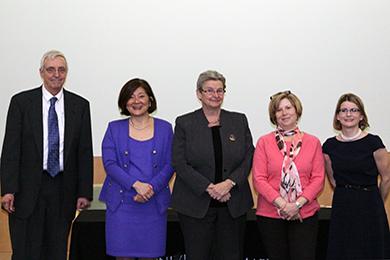Study Finds Medicare MTM Program Enrollment Varies with Eligibility Criteria
A drug plan with the most restrictive eligibility criteria enrolled just 0.2 percent of beneficiaries compared to another plan with more generous eligibility criteria, which enrolled 57 percent of its beneficiaries.
By Malissa Carroll
September 9, 2016
A study led by Bruce Stuart, PhD, professor in the Department of Pharmaceutical Health Services Research (PHSR) at the University of Maryland School of Pharmacy, has found that patients’ enrollment in Medicare Part D medication therapy management (MTM) programs varies according to programs’ eligibility criteria. Published in the September issue of Health Affairs, the study shows that a plan with the most restrictive eligibility criteria enrolled only 0.2 percent of beneficiaries, while a plan with more generous criteria enrolled 57 percent of its beneficiaries.
“The Centers for Medicare and Medicaid Services (CMS) mandates that Part D plans enroll beneficiaries to receive MTM services if they meet certain eligibility requirements,” says Stuart. “However, the organizations (sponsors) that manage these plans have the freedom to select the specific conditions and number and class of medications that qualify beneficiaries to receive these services. To help improve the program, it is important for researchers to understand how sponsors use this flexibility to select their eligibility criteria and what impact their decisions have on beneficiaries’ access to MTM services across the Part D marketplace.”
Medication-related problems remain an important public health concern in the United States. MTM refers to a broad range of health care services – usually provided by pharmacists – designed to help patients achieve the greatest benefits from their medications. MTM services can include medication therapy reviews, pharmacotherapy consultations, anticoagulation management, immunizations, health and wellness programs, and many other clinical services. By making these services accessible to patients who take multiple medications to manage multiple chronic conditions, pharmacists and other health care professionals can actively manage patients’ drug therapy and help identify, prevent, and resolve any medication-related problems.
After analyzing 532 Part D plans from 2012 – the latest year for which complete information was available – Stuart and his colleagues found that enrollment rates in MTM programs among stand-alone prescription drug programs and Medicare Advantage drug plans averaged only 10 percent. In addition, enrollment variation across plans – from less than 0.2 percent to more than 57 percent – showed a direct correlation to the restrictiveness of the plans’ eligibility criteria.
Funded by the National Association of Chain Drug Stores (NACDS) and the Pharmaceutical Research and Manufacturers of America (PhRMA), the study revealed that 90 percent of all Part D beneficiaries were in plans that required a minimum of three chronic conditions for MTM eligibility. However, the enrollment rate for those plans was only 9.2 percent – nearly six percent lower than the 16.4 percent enrollment rate among plans that required only two chronic conditions. Plans that restricted qualifying medications to certain classes showed only a 4.4 percent enrollment rate – approximately nine percent lower than the 12.7 percent enrollment rate for plans that allowed the use of any Part D drug.
In addition, nearly 70 percent of beneficiaries were in plans that required at least eight medications to be prescribed before becoming eligible to enroll in a MTM program. However, Stuart and his colleagues found that enrollment rates for plans requiring a minimum of eight qualifying medications were approximately 8 percent less than plans that required fewer than five medications.
“The most likely explanation for these differences in eligibility criteria is that sponsors simply differ in their assessment of the costs of and returns from MTM interventions,” says Stuart. “But, differences in enrollment rates can have important consequences for beneficiaries, with the most significant ramification being that beneficiaries with identical medication-related problems will be eligible for MTM services in one Part D plan, but not in another. The opportunity for beneficiaries to participate in a comprehensive medication review at least opens the possibility for resolution of a medication-related problem.”
However, Stuart and his colleagues are hopeful that the new Part D Enhanced Medication Therapy Management model announced by CMS – for which pilot testing begins in 2017 – will significantly increase the impact of MTM services by aligning financial incentives with improvements in medication use and encouraging innovation.
“CMS has long recognized shortcomings in the MTM program. This new model, which is designed to meet the triple aim of better care, smarter spending, and healthier people, will be open to prescription drug plans in 11 states and give insurers the flexibility to focus on MTM interventions that prevent adverse outcomes and achieve savings in health care costs,” he adds.
Stuarts’ collaborators on the study included Sarah Tom, PhD, assistant professor in PHSR; Franklin Hendrick and Xian Shen, doctoral candidates in the PHSR PhD Program; Mingliang Dai, doctoral candidate in gerontology at the University of Maryland, Baltimore County (UMBC); J. Samantha Dougherty, PhD, director of policy and research for PhRMA; and Laura Miller, senior economist at NACDS.



